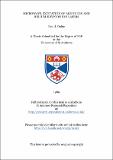Files in this item
Microwave excitation of argon ion and helium-krypton ion lasers
Item metadata
| dc.contributor.advisor | Maitland, Arthur | |
| dc.contributor.author | Dobie, Paul J. | |
| dc.coverage.spatial | 184 p. | en_US |
| dc.date.accessioned | 2018-06-18T09:21:13Z | |
| dc.date.available | 2018-06-18T09:21:13Z | |
| dc.date.issued | 1989-07 | |
| dc.identifier.uri | https://hdl.handle.net/10023/14163 | |
| dc.description.abstract | Pulsed microwave excitation of noble gas ion lasers at frequencies between 3 and 17 GHz is investigated. The advantages of using microwaves instead of conventional DC sources to pump a laser are explained. These include the lower electrode and discharge tube wear due to the oscillating nature of a microwave electric field. The propagation of microwave radiation in an ionised gas is examined. At the frequencies used, the skin depth of an Argon ion laser discharge is shown to be approximately 1 mm, indicating good microwave power absorption. The dependence of the microwave power absorption on the frequency is shown to be weak. Microwave transmission at a dielectric/gas-discharge boundary, similar to those in the laser coupling structures used, is found to be around 1% of the incident power. It is suggested that for maximum laser efficiency, microwave power should be introduced directly into the gas discharge. Two microwave coupling structure designs for supplying microwave power to the laser discharges are described. The first of these, a waveguide coupler device based on the 3dB branch guide coupler, produces a transverse electric field across the laser tube. The procedure used to design a branch guide coupler using a Chebyshev impedance taper and T- junction discontinuity corrections is outlined, and a description of the entire laser coupling structure is given. The second design comprises a helix wrapped round the laser tube and produces an axial electric field. The electric field distribution around a helix is calculated as a function of helix parameters and the effects of surrounding objects are considered. The best helix dimensions are found for optimum laser operation. The characteristics of conventional Argon ion and Helium-Krypton ion lasers are given. No significant differences between conventional noble gas ion lasers and the microwave excited lasers reported here are observed. At the input powers used (~100 kW peak, 1 uS pulses, 1000 pps), 100 mW, 1 uS and 30 mW, 5 uS laser pulses are observed from Argon and Helium-Krypton gas mixtures, respectively. The transverse and axially excited lasers perform equally well. | en_US |
| dc.language.iso | en | en_US |
| dc.publisher | University of St Andrews | |
| dc.subject.lcc | TK7872.L3D7 | |
| dc.subject.lcsh | Lasers | |
| dc.title | Microwave excitation of argon ion and helium-krypton ion lasers | en_US |
| dc.type | Thesis | en_US |
| dc.type.qualificationlevel | Doctoral | en_US |
| dc.type.qualificationname | PhD Doctor of Philosophy | en_US |
| dc.publisher.institution | The University of St Andrews | en_US |
This item appears in the following Collection(s)
Items in the St Andrews Research Repository are protected by copyright, with all rights reserved, unless otherwise indicated.

